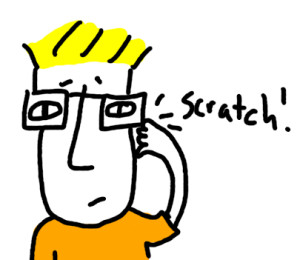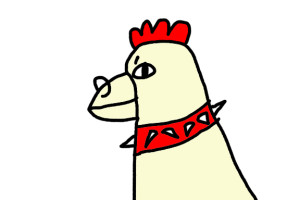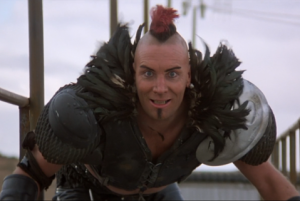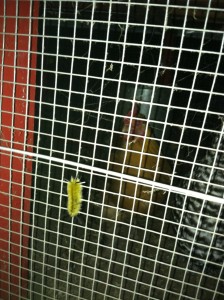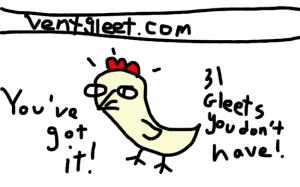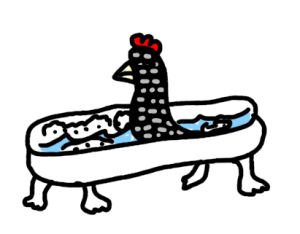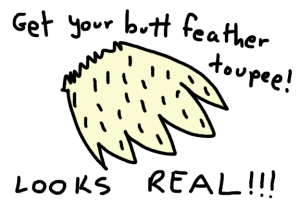Somebody’s Molting!
Friday, September 27th, 2013(Broadcast 9/27/2013)
Recently I’ve noticed loose feathers around the coop and run, which is really not shocking in the least. We’ve got a bunch of birds hanging out in there, it seems pretty obvious that there will be the odd occasional feather that comes detached from it’s host, and there you go. O.k., well, see you next week! Then one day I opened the coop door to get eggs, and it looked like one of the Mandrell Sisters had exploded. First thing I had to do was confirm that all chickens were in a non-exploded state. Check. Ok, so then what would make this happen? My first thought was someone was molting, but of course, being the paranoid type who likes to look things up, I decided to make sure there weren’t other, more sinister things at play.
There are a number of things that can make a chicken lose her feathers. One is a change of diet. I knew I could rule this out, since we’re very much steady as she goes in terms of the commercial food they get. We supplement that with vegetable scraps and other odds and ends, but nothing that would cause a shortage of any nutrition, or be considered a shocking change. They’re nothing if not well-fed.
That brings us to the issue of parasites, which always makes me a little itchy. There are plenty of little nasty critters that can make a chicken’s feathers fall out, so this was a worry. These can usually be ruled out by an examination of the chicken and the coop. Having cats, I know what to look for if fleas are involved. They leave the innocuous sounding “dirt” behind, which is their poop. It’s not as helpful as chicken poop in the garden. It’s really only good for figuring out if fleas are around. But I didn’t see any of this dirt on my birds. I didn’t see much of anything, really. A lot of parasites will leave bites or other marks on the skin, which will be a giveaway, even if you don’t see the bugs themselves. All I was seeing was lovely clean chicken skin. If chicken skin can ever been called lovely. Let’s say normal chicken skin. The normalness of their skin also helped me to rule out another nasty cause of feather loss – aggressive pecking. I had a chicken pecking at another one once, but I caught it very early on. I know what the results look like, and they aren’t pretty. Lots of blood and scabs. I’d have noticed this.
Molting can be triggered by the change in the length of days. Well, here we are with it getting darker much earlier, so I was beginning to suspect this was definitely my culprit. Chickens do go through an annual molt, and since mine are just over a year old, it looks like it may be time to ring in the New Year. As time went on, it became clearer that one of the Mandrell sisters had lost some feathers. The area around her neck started to get very thin. A typical molt starts at the neck and then moves down the body. What’s cool about new feathers is that they look a little like fish bones when they first appear. The soft part of the feather is contained in a tube, which slowly breaks away and then the feather as we know it emerges. What’s cool in concept can be very freaky in reality, especially when you look at your chicken and she seems to be wearing a necklace of spines. So edgy.
There are two types of molting. One is the “typical” molt, and one is the “rough” molt. The typical molt means that the feathers fall out, but it’s sort of like a cat shedding. The chicken still looks fairly normal, but may have some spots that look a little sparsely feathered. The rough molt is something out of a chicken horror movie, or maybe more accurately, The Chicken Road Warrior. There’s a lot of skin, and weird tufts of feathers sticking out all over the place. It looks like mange, but because chickens look so odd when you can see their skin, it’s much, much creepier.
Luckily, we seem to be going through a typical molt. The first chicken I noticed was molting had some spiny feathers on her neck, and now her wings look a little ragged, but otherwise she seems fine. She just looks a little shabby chic. Another Mandrell Sister seems to have jumped on the bandwagon, so they can at least commiserate about the indignities of molting in front of the others. Chickens need support groups too. I just hope the feathers are back before it gets too cold. I understand the biological mechanisms behind sunlight triggering the molt, but it seems silly to have it happen when it’s getting cooler, rather than when it’s really warm out. But I assume they know what they’re doing. Which is probably a bad thing to assume, since they are chickens.


